Abstract
Toxic shock syndrome toxin 1 (TSST-1) was purified to apparent homogeneity by chromatofocusing and affinity chromatography. The amino acid composition of the toxin was very similar to that reported for TSST-1 by other investigators. The amino-terminal amino acid was serine. A partial specific volume of 0.73 ml/g was calculated for the toxin from the amino acid data, and a molecular weight of 19,200 +/- 1,300 was determined by hydrodynamic methods. New Zealand white rabbits of both sexes were equally susceptible to the lethal effects of the toxin; however, older rabbits (greater than 12 months) were far more susceptible than young adults or weanlings. The 50% lethal dose of TSST-1 in older rabbits was 50 to 60 micrograms/kg when injected subcutaneously and 20 to 30 micrograms/kg when injected intravenously. Enhancement of lethal endotoxin shock by TSST-1 could not be demonstrated when both toxins were injected subcutaneously; however, lethal shock did occur when endotoxin (10 micrograms/kg) was injected intravenously after TSST-1 had been injected by either the subcutaneous (50 to 60 micrograms/kg) or the intravenous (20 to 30 micrograms/kg) route. Endotoxin alone was not lethal at a dose of 500 micrograms/kg of body weight when injected subcutaneously. When injected intravenously, endotoxin at a dose of 500 micrograms/kg was not lethal in weanling males or in females in any age group; however, young (6 to 7 months) and adult (greater than 12 months) males were killed by endotoxin doses as low as 45 to 50 micrograms/kg. Histopathologic studies of rabbits by both sexes which died as a result of TSST-1 alone or in combination with endotoxin showed extensive damage to organs rich in lymphoid and mononuclear phagocytic cells such as the thymus, mesenteric lymph nodes, liver, and spleen. Severe congestion of these organs as well as erythrophagocytosis and lymphoid depletion in the spleen and mesenteric lymph nodes were noted. Congestion and hemorrhage were also found in the heart, lungs, trachea, and thymus. The systemic pathology produced by TSST-1 was strikingly similar to that seen in humans who had died of toxic shock syndrome and in rabbits with subcutaneous chamber inoculated with toxic shock case strains of Staphylococcus aureus. Rabbits that were not killed by the toxin suffered a very rapid and severe leukopenia followed by leukocytosis with a left shift. Lymphopenia was also noted as was a mild but persistent anemia. With the exception of the early leukopenia, very similar hematologic findings have been noted in humans with toxic shock syndrome.
Full text
PDF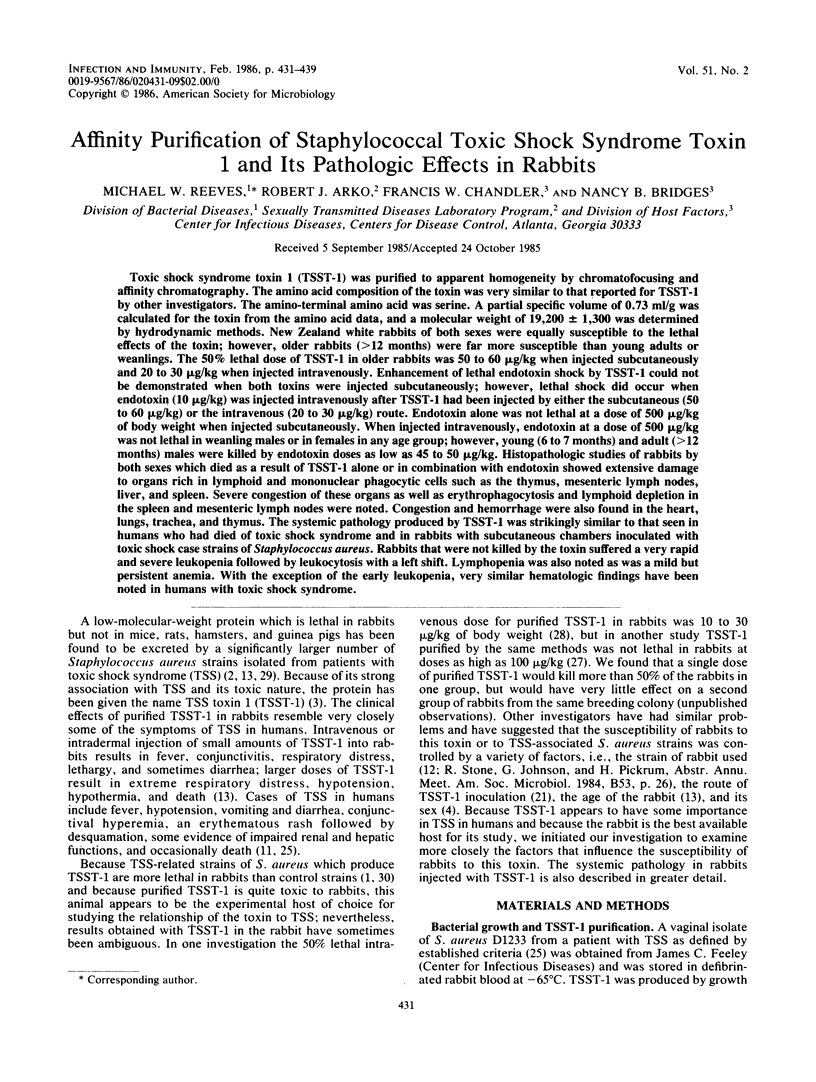

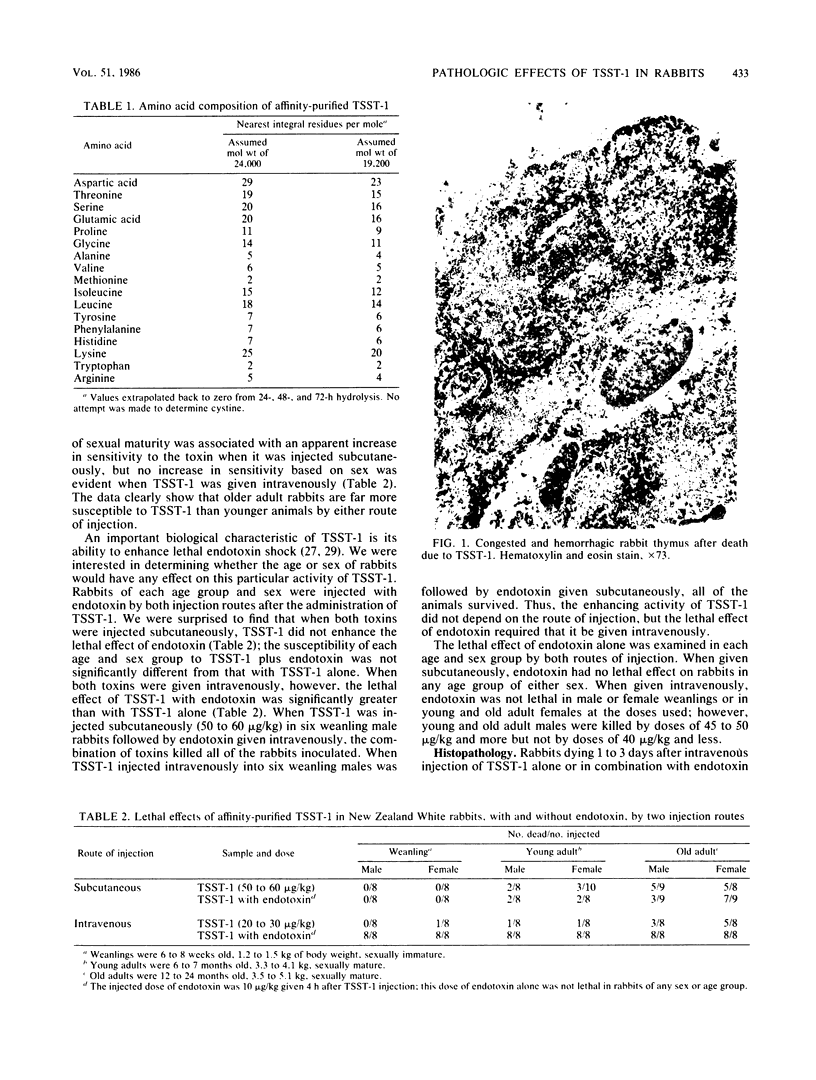
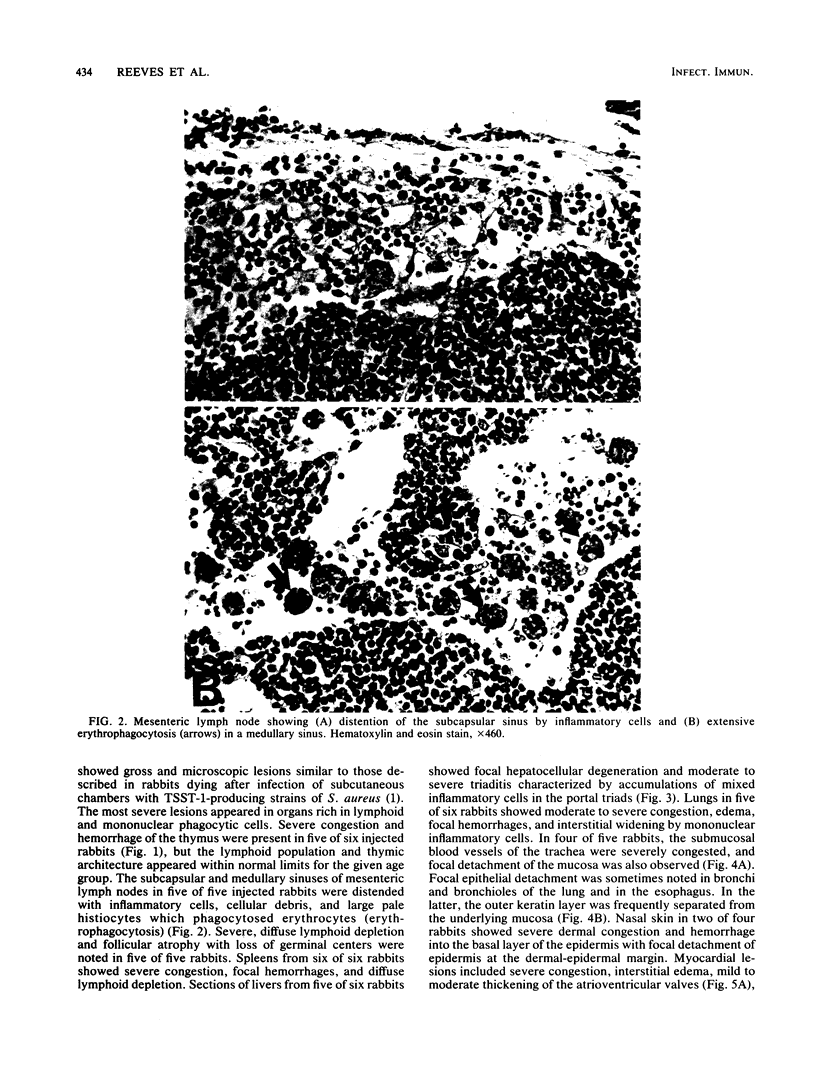
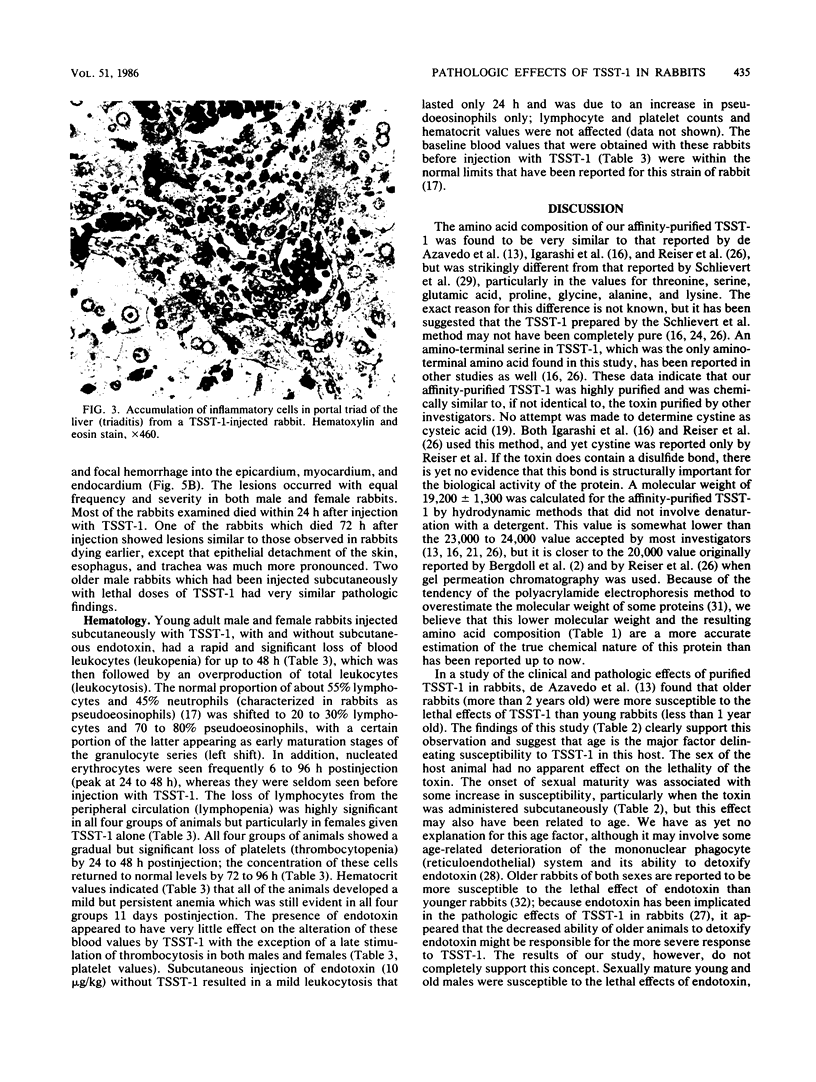


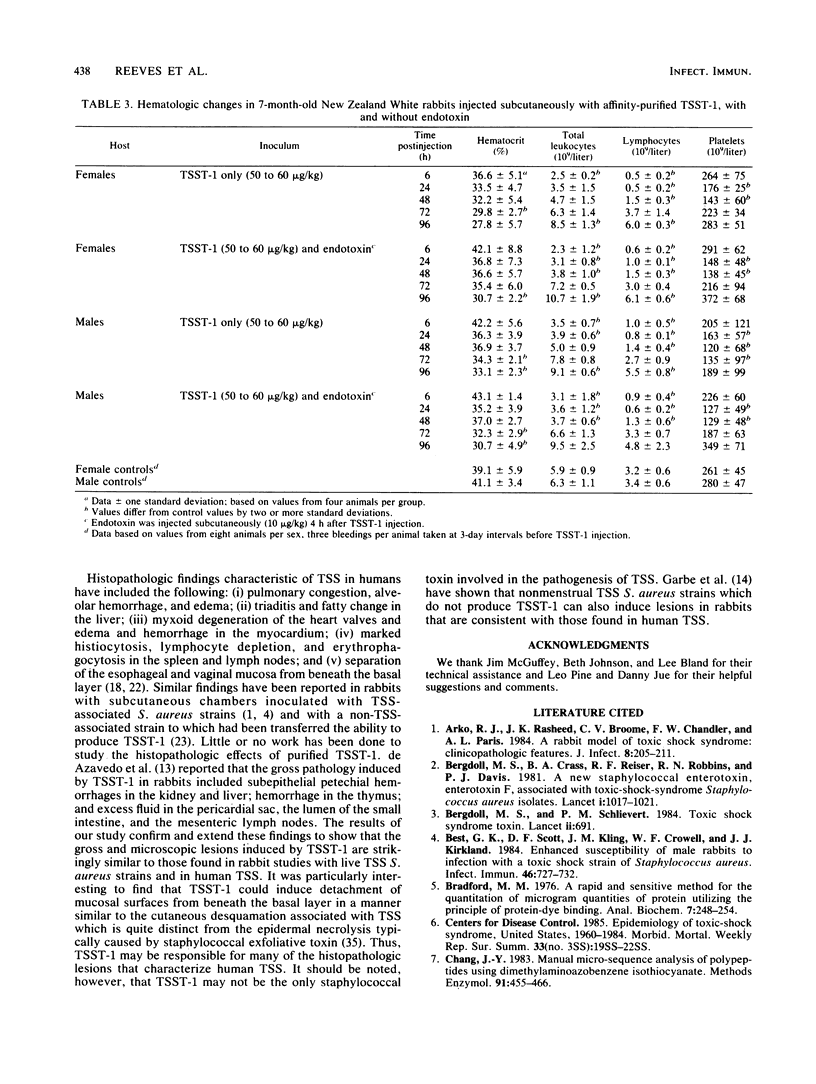

Images in this article
Selected References
These references are in PubMed. This may not be the complete list of references from this article.
- Arko R. J., Rasheed J. K., Broome C. V., Chandler F. W., Paris A. L. A rabbit model of toxic shock syndrome: clinicopathological features. J Infect. 1984 May;8(3):205–211. doi: 10.1016/s0163-4453(84)93859-3. [DOI] [PubMed] [Google Scholar]
- Bergdoll M. S., Crass B. A., Reiser R. F., Robbins R. N., Davis J. P. A new staphylococcal enterotoxin, enterotoxin F, associated with toxic-shock-syndrome Staphylococcus aureus isolates. Lancet. 1981 May 9;1(8228):1017–1021. doi: 10.1016/s0140-6736(81)92186-3. [DOI] [PubMed] [Google Scholar]
- Best G. K., Scott D. F., Kling J. M., Crowell W. F., Kirkland J. J. Enhanced susceptibility of male rabbits to infection with a toxic shock strain of Staphylococcus aureus. Infect Immun. 1984 Dec;46(3):727–732. doi: 10.1128/iai.46.3.727-732.1984. [DOI] [PMC free article] [PubMed] [Google Scholar]
- Bradford M. M. A rapid and sensitive method for the quantitation of microgram quantities of protein utilizing the principle of protein-dye binding. Anal Biochem. 1976 May 7;72:248–254. doi: 10.1016/0003-2697(76)90527-3. [DOI] [PubMed] [Google Scholar]
- Chang J. Y. Manual micro-sequence analysis of polypeptides using dimethylaminoazobenzene isothiocyanate. Methods Enzymol. 1983;91:455–466. doi: 10.1016/s0076-6879(83)91043-1. [DOI] [PubMed] [Google Scholar]
- Chesney P. J., Davis J. P., Purdy W. K., Wand P. J., Chesney R. W. Clinical manifestations of toxic shock syndrome. JAMA. 1981 Aug 14;246(7):741–748. [PubMed] [Google Scholar]
- Davis J. P., Chesney P. J., Wand P. J., LaVenture M. Toxic-shock syndrome: epidemiologic features, recurrence, risk factors, and prevention. N Engl J Med. 1980 Dec 18;303(25):1429–1435. doi: 10.1056/NEJM198012183032501. [DOI] [PubMed] [Google Scholar]
- Garbe P. L., Arko R. J., Reingold A. L., Graves L. M., Hayes P. S., Hightower A. W., Chandler F. W., Broome C. V. Staphylococcus aureus isolates from patients with nonmenstrual toxic shock syndrome. Evidence for additional toxins. JAMA. 1985 May 3;253(17):2538–2542. [PubMed] [Google Scholar]
- Helms C. M., Lengeling R. W., Pinsky R. L., Myers M. G., Koontz F. P., Klassen L. W., Wintermeyer L. A. Toxic shock syndrome: a retrospective study of 25 cases from Iowa. Am J Med Sci. 1981 Sep-Oct;282(2):50–60. doi: 10.1097/00000441-198109000-00001. [DOI] [PubMed] [Google Scholar]
- Igarashi H., Fujikawa H., Usami H., Kawabata S., Morita T. Purification and characterization of Staphylococcus aureus FRI 1169 and 587 toxic shock syndrome exotoxins. Infect Immun. 1984 Apr;44(1):175–181. doi: 10.1128/iai.44.1.175-181.1984. [DOI] [PMC free article] [PubMed] [Google Scholar]
- Larkin S. M., Williams D. N., Osterholm M. T., Tofte R. W., Posalaky Z. Toxic shock syndrome: clinical, laboratory, and pathologic findings in nine fatal cases. Ann Intern Med. 1982 Jun;96(6 Pt 2):858–864. doi: 10.7326/0003-4819-96-6-858. [DOI] [PubMed] [Google Scholar]
- Notermans S., Dufrenne J. B. A simple purification method for enterotoxin F produced by Staphylococcus aureus and some properties of the toxin. Antonie Van Leeuwenhoek. 1982 Dec;48(5):447–455. doi: 10.1007/BF00448416. [DOI] [PubMed] [Google Scholar]
- Paris A. L., Herwaldt L. A., Blum D., Schmid G. P., Shands K. N., Broome C. V. Pathologic findings in twelve fatal cases of toxic shock syndrome. Ann Intern Med. 1982 Jun;96(6 Pt 2):852–857. doi: 10.7326/0003-4819-96-6-852. [DOI] [PubMed] [Google Scholar]
- Rasheed J. K., Arko R. J., Feeley J. C., Chandler F. W., Thornsberry C., Gibson R. J., Cohen M. L., Jeffries C. D., Broome C. V. Acquired ability of Staphylococcus aureus to produce toxic shock-associated protein and resulting illness in a rabbit model. Infect Immun. 1985 Mar;47(3):598–604. doi: 10.1128/iai.47.3.598-604.1985. [DOI] [PMC free article] [PubMed] [Google Scholar]
- Reeves M. W., Pine L., Feeley J. C., Wells D. E. Presence of toxic shock toxin in toxic shock and other clinical strains of Staphylococcus aureus. Infect Immun. 1984 Nov;46(2):590–597. doi: 10.1128/iai.46.2.590-597.1984. [DOI] [PMC free article] [PubMed] [Google Scholar]
- Reingold A. L., Hargrett N. T., Shands K. N., Dan B. B., Schmid G. P., Strickland B. Y., Broome C. V. Toxic shock syndrome surveillance in the United States, 1980 to 1981. Ann Intern Med. 1982 Jun;96(6 Pt 2):875–880. doi: 10.7326/0003-4819-96-6-875. [DOI] [PubMed] [Google Scholar]
- Reiser R. F., Robbins R. N., Khoe G. P., Bergdoll M. S. Purification and some physicochemical properties of toxic-shock toxin. Biochemistry. 1983 Aug 2;22(16):3907–3912. doi: 10.1021/bi00285a028. [DOI] [PubMed] [Google Scholar]
- SMITH R. T., THOMAS L. Influence of age upon response to meningococcal endotoxin in rabbits. Proc Soc Exp Biol Med. 1954 Aug-Sep;86(4):806–809. doi: 10.3181/00379727-86-21239. [DOI] [PubMed] [Google Scholar]
- SUGIYAMA H., MCKISSIC E. M., Jr, BERGDOLL M. S., HELLER B. ENHANCEMENT OF BACTERIAL ENDOTOXIN LETHALITY BY STAPHYLOCOCCAL ENTEROTOXIN. J Infect Dis. 1964 Apr;114:111–118. doi: 10.1093/infdis/114.2.111. [DOI] [PubMed] [Google Scholar]
- Schlievert P. M. Alteration of immune function by staphylococcal pyrogenic exotoxin type C: possible role in toxic-shock syndrome. J Infect Dis. 1983 Mar;147(3):391–398. doi: 10.1093/infdis/147.3.391. [DOI] [PubMed] [Google Scholar]
- Schlievert P. M. Enhancement of host susceptibility to lethal endotoxin shock by staphylococcal pyrogenic exotoxin type C. Infect Immun. 1982 Apr;36(1):123–128. doi: 10.1128/iai.36.1.123-128.1982. [DOI] [PMC free article] [PubMed] [Google Scholar]
- Schlievert P. M., Shands K. N., Dan B. B., Schmid G. P., Nishimura R. D. Identification and characterization of an exotoxin from Staphylococcus aureus associated with toxic-shock syndrome. J Infect Dis. 1981 Apr;143(4):509–516. doi: 10.1093/infdis/143.4.509. [DOI] [PubMed] [Google Scholar]
- Scott D. F., Kling J. M., Kirkland J. J., Best G. K. Characterization of Staphylococcus aureus isolates from patients with toxic shock syndrome, using polyethylene infection chambers in rabbits. Infect Immun. 1983 Jan;39(1):383–387. doi: 10.1128/iai.39.1.383-387.1983. [DOI] [PMC free article] [PubMed] [Google Scholar]
- Todd J., Fishaut M., Kapral F., Welch T. Toxic-shock syndrome associated with phage-group-I Staphylococci. Lancet. 1978 Nov 25;2(8100):1116–1118. doi: 10.1016/s0140-6736(78)92274-2. [DOI] [PubMed] [Google Scholar]
- Tofte R. W., Williams D. N. Clinical and laboratory manifestations of toxic shock syndrome. Ann Intern Med. 1982 Jun;96(6 Pt 2):843–847. doi: 10.7326/0003-4819-96-6-843. [DOI] [PubMed] [Google Scholar]
- Tsang V. C., Peralta J. M., Simons A. R. Enzyme-linked immunoelectrotransfer blot techniques (EITB) for studying the specificities of antigens and antibodies separated by gel electrophoresis. Methods Enzymol. 1983;92:377–391. doi: 10.1016/0076-6879(83)92032-3. [DOI] [PubMed] [Google Scholar]
- Van Miert A. S., Van Duin C. T., Schotman A. J. Comparative observations of fever and associated clinical hematological and blood biochemical changes after intravenous administration of staphylococcal enterotoxins B and F (toxic shock syndrome toxin-1) in goats. Infect Immun. 1984 Nov;46(2):354–360. doi: 10.1128/iai.46.2.354-360.1984. [DOI] [PMC free article] [PubMed] [Google Scholar]
- de Azavedo J. C., Arbuthnott J. P. Toxicity of staphylococcal toxic shock syndrome toxin 1 in rabbits. Infect Immun. 1984 Nov;46(2):314–317. doi: 10.1128/iai.46.2.314-317.1984. [DOI] [PMC free article] [PubMed] [Google Scholar]







